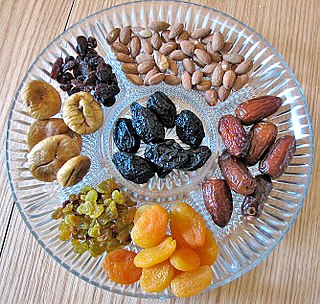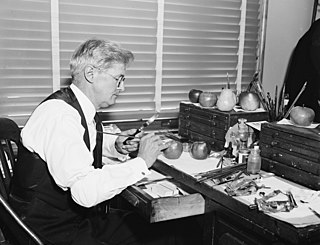
A fruit tree is a tree which bears fruit that is consumed or used by animals and humans — all trees that are flowering plants produce fruit, which are the ripened ovaries of flowers containing one or more seeds. In horticultural usage, the term "fruit tree" is limited to those that provide fruit for human food. Types of fruits are described and defined elsewhere, but would include "fruit" in a culinary sense, as well as some nut-bearing trees, such as walnuts.

Pollination of fruit trees is required to produce seeds with surrounding fruit. It is the process of moving pollen from the anther to the stigma, either in the same flower or in another flower. Some tree species, including many fruit trees, do not produce fruit from self-pollination, so pollinizer trees are planted in orchards.

Dried fruit is fruit from which the majority of the original water content has been removed either naturally, through sun drying, or through the use of specialized dryers or dehydrators. Dried fruit has a long tradition of use dating back to the fourth millennium BC in Mesopotamia, and is prized because of its sweet taste, nutritive value, and long shelf life.

Forbidden fruit is a name given to the fruit growing in the Garden of Eden which God commands mankind not to eat. In the biblical story, Adam and Eve ate the fruit from the tree of the knowledge of good and evil and are exiled from Eden:
And the Lord God commanded the man, saying, Of every tree of the garden thou mayest freely eat:
But of the tree of the knowledge of good and evil, thou shalt not eat of it: for in the day that thou eatest thereof thou shalt surely die.

Pyrus communis, the common pear, is a species of pear native to central and eastern Europe, and western Asia.

Spoon sweets are sweet preserves, served in a spoon as a gesture of hospitality in Bosnia, Serbia, Albania, Greece, Turkey, Kosovo, Cyprus, the Balkans, parts of the Middle East, and Russia. They can be made from almost any fruit, though sour and bitter fruits are especially prized. There are also spoon sweets produced without fruit.

George McMillan Darrow (1889–1983) was an American horticulturist and the foremost authority on strawberries. He worked for the United States Department of Agriculture (USDA-ARS) for forty-six years as the pomologist in charge of research on deciduous fruit production, and authored a multitude of papers on planting and cultivating small fruits.
William Coxe Jr. was a pioneer pomologist and a U.S. Representative from New Jersey. He served as Mayor of Burlington, New Jersey, from 1807 to 1815.

Charles Downing, was an American pomologist, horticulturist, and author.

Ulysses Prentiss Hedrick (1870–1951) was an American botanist and horticulturist.

Iran ranks 1st in fruit production in the Middle East and North Africa. Iran has been ranked between 8th and 10th in global fruit production in different years. Iran produces Persian walnut, melon, tangerine, citrus fruits, Kiwifruit, dates, cherries, pomegranates, peach, oranges, raisins, saffron, grapes, Apricot, Pitted Prune and watermelon.
James Marion Shull (1872–1948) was an American botanist known for his iris and daylily cultivars and botanical illustrations.

Deborah Griscom Passmore (1840–1911) was a botanical illustrator for the U.S. Department of Agriculture who specialized in paintings of fruit. Her work is now preserved in the USDA's Pomological Watercolor Collection, and she has been called the best of the early USDA artists. She rose to lead the USDA staff artists, and she became the most prolific of the group, contributing one-fifth of the 7500 paintings in the Pomological Watercolor Collection.

Amanda Almira Newton was a botanical illustrator for the U.S. Department of Agriculture (USDA) who specialized in watercolors of fruit. Her work is now preserved in the USDA's Pomological Watercolor Collection, and she is the second-most prolific contributor to that archive of 7600 paintings, with her work representing roughly one-sixth of the total.

Pickled fruit refers to fruit that has been pickled. Pickling is the process of food preservation by either anaerobic fermentation in brine or immersion in vinegar. Many types of fruit are pickled. Some examples include peaches, apples, crabapples, pears, plums, grapes, currants, tomatoes and olives. Vinegar may also be prepared from fruit, such as apple cider vinegar.

Royal Charles Steadman was a botanical illustrator and wax fruit modeler for the United States Department of Agriculture (USDA) who also developed a patented method of strengthening wax fruit with plaster on the interior.

Ellen Isham Schutt was an early 20th-century American botanical illustrator for the U.S. Department of Agriculture. Her work now forms part of the USDA National Agricultural Library's Pomological Watercolor Collection.

The U.S. Department of Agriculture's Pomological Watercolor Collection is an archive of some 7,500 botanical watercolors created for the USDA between the years 1886 and 1942 by around five dozen artists. Housed by the United States National Agricultural Library, it is a unique resource documenting existing fruit and nut cultivars, new introductions, and specimens discovered by USDA's plant explorers, representing 38 plant families in all. It has been called "one of the world's most unusual holdings of late 19th and early 20th century American botanical illustrations".

Mary Daisy Arnold was a botanical artist who worked for the United States Department of Agriculture (USDA) for over thirty-five years, painting watercolors of a wide variety of fruits. She is one of the three most prolific artists whose work is now preserved in the USDA's Pomological Watercolor Collection.
The fruit sector in Azerbaijan is a developing industry. The sector covered 171,600 ha. of land in 2016. Grape, apple, orange, pear and pomegranate are one of the major crops in fruit production in Azerbaijan.

















